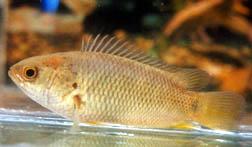 Ikan puyu mempunyai khasiat yang sama dengan ikan-ikan air tawar yang lain, biarpun persepsi masyarakat menganggap ikan puyu sebagai ikan paya atau ikan lumpur. Ikan puyu merupakan spesis ikan air tawar paling lasak kerana bentuknya bersisik licin dan bersirip tajam, mempunyai jangka hayat yang lama dan mampu hidup lebih lama di atas darat walaupun tanpa air. Biasanya ikan puyu ini akan dibiarkan untuk tempoh 2-3 hari sebelum dimasak bagi tujuan menghilangkan bau lumpur.
Ikan puyu mempunyai khasiat yang sama dengan ikan-ikan air tawar yang lain, biarpun persepsi masyarakat menganggap ikan puyu sebagai ikan paya atau ikan lumpur. Ikan puyu merupakan spesis ikan air tawar paling lasak kerana bentuknya bersisik licin dan bersirip tajam, mempunyai jangka hayat yang lama dan mampu hidup lebih lama di atas darat walaupun tanpa air. Biasanya ikan puyu ini akan dibiarkan untuk tempoh 2-3 hari sebelum dimasak bagi tujuan menghilangkan bau lumpur.Ikan puyu (Climbing Perch) atau nama saintifiknya Anabias Testudineus,turut dipanggil ikan betok.Habitat ikan puyu biasanya di sawah padi, tasik, paya, lubuk dan anak sungai.
SCIENTIFIC NAME - Anabas testudineus
COMMON NAME - Climbing Perch
SCIENTIFIC CONFUSION? - With several slight colour and morphological differences in Climbing Perch found throughout their natural range it may well be that, in the future, we will see some of these given alternative scientific names.
NATURAL RANGE - Thailand, Sri Lanka, Malaysia, Taiwan, Indonesia, Southern China, Vietnam, Cambodia, Philippines.
SIZE - 10" (25cm).
DESCRIPTION - A torpedo looking, perch shaped fish. The body is elongate, the dorsal fin has a longer base than the anal, dorsal and anal reach backwards to the beginning of the caudal and that the posterior edge of the gill cover bears two strong spines. Colour is of a 'muddy' appearance of olive-grey. Young specimens have a dark spot on the caudal peduncle (point at which the body ends and tail starts). Young are often confused with Ctenopoma species.
DANGER? - The gill covers are equipped with various spines that are used as a defensive mechanism and are said to cause pain (if my experience of badly swollen fingers and large blisters caused by the ventral fin spines of Synodontis species 'Nigeria' is similar to this then such contact is best avoided and only plunging my hand into extremely hot water took this swelling down) if they catch a fishkeepers hand.
FIN MOVERS? - These fish are capable of moving from pool to pool by using their pectoral fins, caudal peduncle and gill covers as a means of locomotion. As a means of protection these fish are said to use the cover of darkness in order to move around doing so in groups and not as individuals.
HOW DID THESE FISH GAIN THEIR COMMON NAME? - Climbing Perch came about due to a 'myth'. Because certain individuals are said to have been found in tree tops a 'myth' has spread that these fish are the 'Tarzan of the fish world' able to shin up tree trunks with ease but this has yet to be scientifically proved so it is more likely that fish eating birds actually dropped or left catches of this particular fish on tree branches.
AQUARIUM CONDITIONS - In his Tetra published book Labyrinth Fish - The Bubble-Nest-Builders, Anabantid expert Horst Linke recommends that these fish be maintained in aquaria of 70x40x40cm with a temperature of between 20 and 25 C. Linke recommends keeping these fish in a well-planted aquarium. From a conversation with well-known aquatic photographer Mr. Kevin Webb, maggots and large sized commercial aquarium fish food pellets make good foods for these particular fish. These fish have a predatory nature so are NOT for the community aquarium. The two Climbing Perch I care for live fairly peacefully alongside large Loricarins, Synodontis pardalis, Sajica Cichlids, Doradids and a Garra species.
Please remember that these are labyrinth fish so leave a gap between the water surface and condensation shield (in order to keep the labyrinth organ working properly) and watch for signs of velvet disease.
BREEDING - The sexes are told apart by girth, as that of the female is larger (particularly when in spawning condition). Males may be darker in colour and have more of a knife-edged anal fin than females. Use a large aquarium with plenty of floating plants. These fish do not build nests spawning in open water. Unlike their Gourami relatives they do not entwine in a full embrace. Spawning is said to be a very vigorous affair.Eggs are clear in appearance and rise to the water surface. Once spawning is complete remove the adults, as they are prone to eating their eggs. Any fry which hatch (said to be from day 3 onwards) would be very delicate and require either green water or egg yolk paste as a first food with newly hatched brine shrimp to follow after the first week or so. The fry would be tiny and prone to velvet disease.
REFERENCES
Labyrinth Fish - The Bubble-Nest-Builders by Horst Linke, Tetra Press.
Labyrinth Fish by Helmut Pinter, Barron's Publishing.
Star Animals Series - See & Discover Fish (English edition) - Elsa editions.
Dr. Axelrod's Mini-Atlas, TFH Publications.
SOURCE:
http://www.aquarticles.com/articles/breeding/Marshall_Climbi

No comments:
Post a Comment